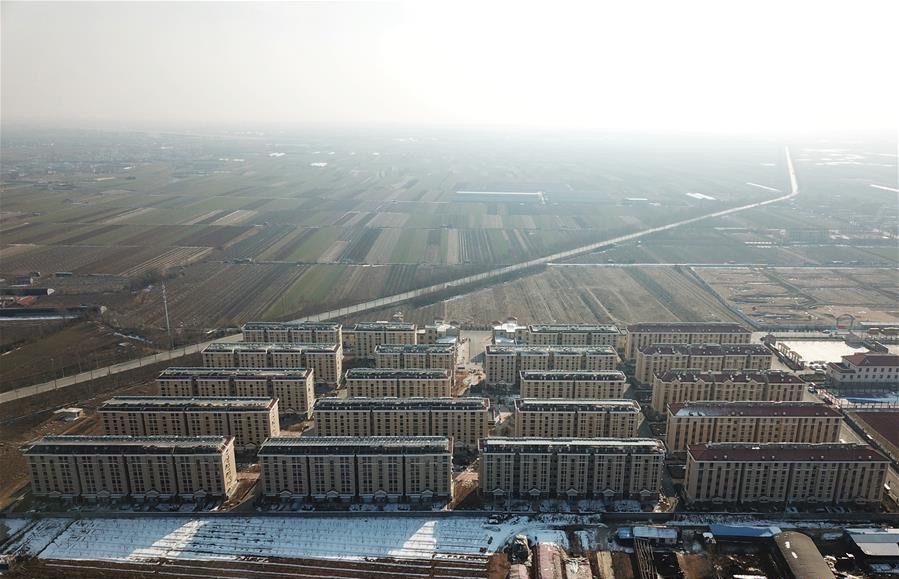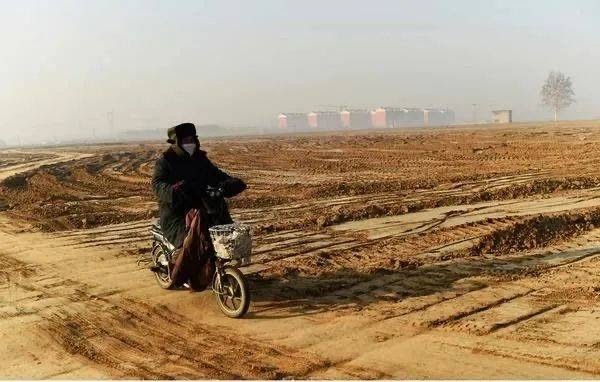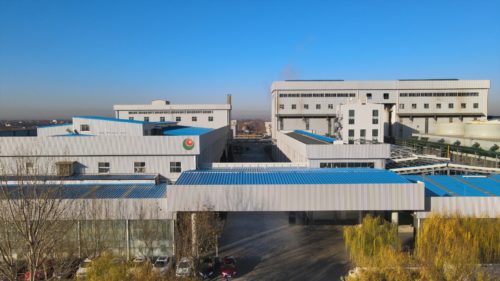A Chinese province razes the countryside. Why?
How are Shandong villagers being convinced to go along with a provincial plan to raze their homes and move them into high-rises? With promises of economic benefits in the future, and if that doesn’t work, with coercion and threats.

Since March, the provincial government of the eastern coastal province of Shandong has been razing villages in the name of rural revitalization. The policy has a name: “village mergers” (合村并居 hécūn bìngjū).
Village mergers are a Shandong-specific term for a broader phenomenon often called “new rural communities” (农村新型社区 nóngcūn xīnxíng shèqū). Simply put, they are mass housing complexes in the countryside. New rural communities are created by razing multiple “natural” villages and consolidating residents into centralized high-rise complexes surrounded by fields. Imagine Bronx blocks amid Iowa cornfields.
Yet in Shandong, the pace and scale of village mergers is dramatically different than other provinces. Zhejiang, often cited as an exemplary rural development story, urbanized more than 3 million rural residents over a period of 15 years. Shandong has mandated results by the end of 2020. Jiazhou City, outside of coastal Qingdao, plans for all 460 villages in the city to be consolidated into 82 central villages by the end of the year. Linyi County, in Dezhou City, will raze 417 villages, with only 31 villages qualifying for special preservation. In total, Dezhou City alone has designated 5,060 villages for destruction, which will force approximately 2.7 million rural residents to relocate.
Coercion and bullying by local officials is central to the village merger campaign. A leaked document from a town in southwestern Shandong’s Heze City showed that local Party cadres demanded all villagers vacate their homes before July 10. The letter threatens that those who resist will “have their homes forcibly torn down on the authority of the village committee.”
This mass-demolition campaign was carried out with limited media attention until June of this year, when a professor in Wuhan University’s Sociology Department published an essay titled, “The real situation in Shandong’s village mergers.”
Professor Lǚ Déwén’s 吕德文 viral essay details the impotence and desperation of villagers who have had their homes torn down on government orders. He writes of harrowing events: a stubborn mother kidnapped by local police, a family painfully aware of the “larger trends” resigning themselves to the loss of their home, elderly parents fleeing from a bulldozer siege, grandmothers sleeping in garages, and tent-villages amidst the rubble. Using four anecdotes from Heze, Laiwu, Binzhou, Linyi — cities across Shandong — Professor Lu details how Shandong’s province-wide campaign to urbanize rural residents has instead left many homeless.
Village mergers are Shandong’s attempt to solve the “sannong problem” (三农问题 sānnóng wèntí): peasants, villages, and agriculture. How to improve farmer livelihoods? How to provide services to far-flung villages? How to industrialize individual plots? To paraphrase The Sound of Music, “What to do with a problem like the countryside?”
At times viewed by Chinese policymakers as “dirty, chaotic, and poor,” the countryside is nonetheless a vanguard of Chinese political reform. The countryside was Chairman Mao’s base during the CCP’s years as a revolutionary party, and has long been a laboratory for “socialism with Chinese characteristics.” During the Great Leap Forward (1958-1962) farmers suffered and died for Mao’s experiments in rural communal living. After the Mao era, villagers moonlighting as capitalism scientists drove forward Opening and Reform. Likewise, the village is both a harbor of traditional culture (see glamorous farmer video star Lǐ Zǐqī 李子柒) and an unwelcome reminder of “past backwardness.” When Premier Lǐ Kèqiáng 李克强 stated that China still has 600 million people living on $140 a month, most living in the countryside, many Chinese netizens were shocked.
Shandong’s village merger policy seeks to solve the sannong problem by imposing order on the “chaotic” countryside and enriching China’s rural poor. Cleared of individual homes and small family plots, rural land is freed for efficient industrial agricultural use. Rural residents, previously faced with the choice of farming locally or migrating in search of greater opportunities, can instead look for local jobs in manufacturing, information, or service sectors that the Party believes will spring from the urbanized new rural communities. Village mergers are therefore viewed as an accelerant to the “natural” urbanization process, and all of the economic and social benefits that process brings.
Raze first, build later. Live in tents for now

Damningly, “raze first, build later” seems to be the order of the day. Villagers’ homes are destroyed before new rural communities are built, leaving rural residents with few options: rent from what housing stock remains, rely on family and friends, or, as many have chosen, erect tents along their old fields. As relocation compensation is reportedly a paltry 600 yuan ($86) per square meter (often less than original construction costs), the forced demolitions have left many already-marginalized residents tottering on the brink of financial disaster.
An anonymous letter (in Chinese) from a grassroots-level cadre in southwestern Heze detailed the impetus behind “raze first, build later”: “[Officials] fear that after building the new communities, the masses will not move,” the cadre wrote. “The high-rises won’t be sold, and governments will face even more financial pressures.” So the officials, it seems, are destroying villagers’ homes to ensure they have no option but to move.
Land expropriation and sale has long been a preferred method of financing for county-level governments. After seizing village land, local governments can package it for sale to land-hungry enterprises and real-estate companies.
During the global recession of the late 2000s, rural infrastructure investment skyrocketed because Chinese officials saw it as a means of ensuring stable growth and employment. A statement (in Chinese) from Heze’s party secretary, implies that a similar impulse may be driving Shandong’s land grab: “Due to the pandemic’s impact, exports have been hindered, consumption is lagging, [so] investment has become a powerful engine for expanding domestic demand and stable growth.”
While the relationship between land expropriation and financial pressure is well established, Shandong’s mass-scale seizures seems excessive even when compared to the already heavy-handed tactics previously employed by local governments and real estate companies.
In an article (in Chinese) titled, “Shandong’s village mergers will bankrupt local government finances,” Hè Xuěfēng 贺雪峰, a prominent sociologist, outlines the impossibility of using capital accrued through the expropriation of land to fund village mergers. He calculates that Shandong’s policy will free upwards of 10 million mu (one mu is approximately two-and-a-half acres) for urban construction. This wildly exceeds both Shandong’s currently in-use urban construction space and projected future needs. There is simply not enough demand for land. Yet, excess supply is the least of He’s concerns.
In a further series of articles shared on the leftist website Utopia, Professor He, long skeptical of engineered urbanization, calls attention to the stabilizing role countryside homes played during the recent pandemic. The countryside served as an “exit ramp” for unemployed migrant laborers, who were able to return to their hometowns while industry ground to a halt during the spring. Without homes to which migrant workers could return to in times of distress, He warns of mass systemic unrest.
A Mao-style campaign?
In village mergers, He Xuefeng sees China’s road to perdition: “The village merger policy Shandong is currently implementing is the Great Leap Forward of these new times.”
As the fiscal logic behind village mergers seems unfounded, some observers wonder whether Shandong’s policy is ideologically driven. Both He Xuefeng and Lu Dewen describe Shandong’s leap as a campaign. Although banned by the party center in the late 1970s, campaigns have remained an important, albeit thorny, part of Chinese development politics. The reform-oriented former premier of China, Zhào Zǐyáng 赵紫阳, lamented in 1987 that, “The Third Plenum resolved that there would be no more mass campaigns. However, people are accustomed to the old ways, so whenever we attack anything, these methods are still used.”
In a phone interview, Kristen Looney, professor at Georgetown University and author of Mobilizing for Development, an analysis of campaign-style rural development in East Asia, clarified that Shandong’s village mergers are neither a new phenomenon nor a return to the movement politics of the Mao era.
“The speed and intensity of this certain campaign is just an accumulation of trends that have been going on from far before Xi arrived in office,” Looney said.
Looney pointed to the New Socialist Countryside, a program initiated under Xi’s predecessor Hú Jǐntāo 胡锦涛, as an antecedent to Shandong’s current village merger campaign. Originally a relatively participatory process between local cadres and villagers focused on the “Three Cleans and Three Reforms” (三清三改 sānqīng sāngāi: removal of trash, mud, and debris; improvement of water supply, toilets, and roads), the New Socialist Countryside devolved into a top-down housing-focused campaign. As successful local experiments become nationally promoted (and then imitated) models, Looney’s analysis shows that consultation between Party and people decreases.
“Campaigns don’t always result in disaster, but when you don’t incorporate any local participation…the consequences can be very severe,” Looney said. “One thing that is really different about Shandong is that they demolish these places without actually having a place for people to move into.”
At first, Shandong provincial authorities denied the existence of mass destruction or construction in the countryside. On June 17, the provincial press office published a transcript of a press conference during which the government reminded cadres to avoid “one-size-fits-all” solutions, and to persist in implementing the policy.
Yet during a June 26 meeting addressing the program, provincial Party Secretary Liú Jiāyì 刘家义 admitted that cadres had not properly sought local counsel, and that in some areas, “there has been a tendency towards recklessness.”
He announced a temporary stop to all uncommenced projects. However, he reaffirmed his commitment to the village mergers, saying, “Good things must be implemented well,” and reminded cadres present that, “Xi Jinping has required us to create the ‘Shandong Model’ of rural revitalization.” Although Liu Jiayi’s June 26 meeting seemingly signals a victory of fact over ideology in Shandong, the specter of “model development” remains.
As for the farmers across the province still sleeping rough, both undercompensated and unheard? In a letter (in Chinese) to He Xuefeng signed by “An ordinary villager, house destroyed against my will, with nowhere to go,” the consequences of reckless policymaking are all too clear.
“Please don’t toss us around again. We truly can’t stand this suffering. We live on the lowest rung of society. It’s really not easy for us.
“I hope that the relevant organs, the Party center, will pay attention to our welfare.
“Isn’t this just burying us villagers alive!”







